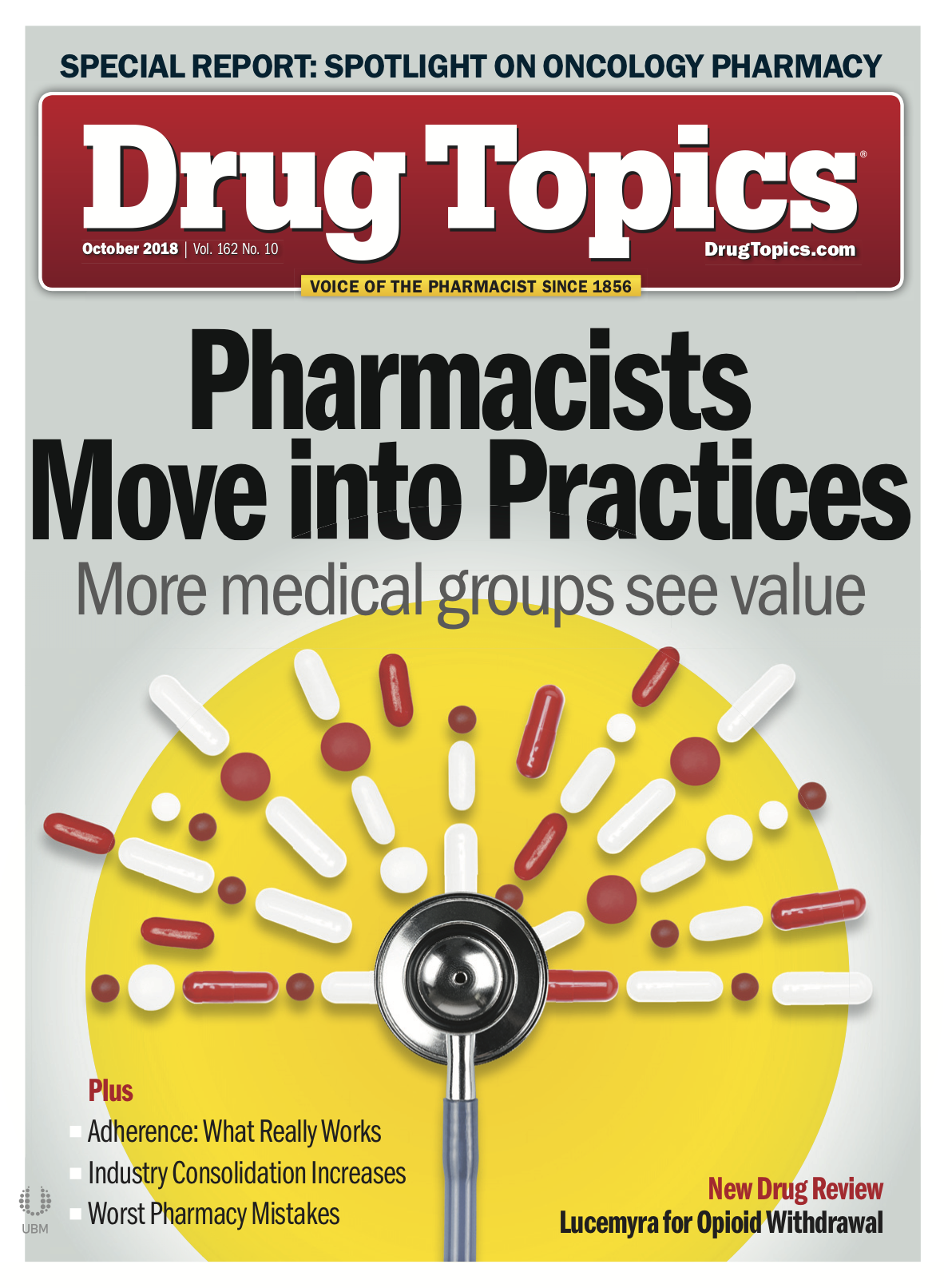The Best Pharmacies, New Pharmacy Degrees, and More News
Small Doses is back, bringing pharmacists the latest clinical and professional news you missed this month.

How Civica Rx Will Impact Drug Shortages
Civica Rx, the new not-for-profit generic drug company formed by a consortium of health systems, could help alleviate shortages of certain critical drugs in hospitals.
The company will initially manufacture 14 hospital-administered generic drugs that have suffered from supply shortages, and then will expand production to other medications. The organization is not naming the drugs it will manufacture for competitive reasons, according to a statement.
Civica Rx says it expects to save the U.S. healthcare system hundreds of millions of dollars annually. “Research into the actual costs of manufacturing and distributing generic drugs suggests that, in many instances, prices for generic drugs used in hospitals can be reduced to a fraction of their current costs,” the organization says.
Related article: Why Health Systems Are Making Their Own Generics
The seven initial governing members of Civica Rx-which represent about 500 U.S. hospitals-are: Catholic Health Initiatives, HCA Healthcare, Intermountain Healthcare, Mayo Clinic, Providence St. Joseph Health, SSM Health, and Trinity Health. More than 120 other health organizations could also become involved.
“The fact that a third of the country’s hospitals have either expressed interest or committed to participate with Civica Rx shows a great need for this initiative. This will improve the situation for patients by bringing much needed competition to the generic drug market,” says Martin VanTrieste, Civica Rx’s CEO and former chief quality officer for Amgen, in a statement.
VanTrieste agreed to lead the new organization without compensation.
Civica Rx will be an FDA-approved manufacturer that will manufacture some drugs itself and will subcontract manufacturing for others. It says it expects to have some medications available as early as next year.
Highest-Rated Retail and Mail Order Pharmacies
Consumers rank Sam’s Club, Good Neighbor Pharmacy, Wegmans, and Humana Pharmacy best within their individual categories in terms of customer satisfaction, according to a new survey.
In the J.D. Power 2018 U.S. Pharmacy Study, Good Neighbor Pharmacy ranks highest overall among chain drug stores, followed by Health Mart and Rite Aid Pharmacy.
Sam’s Club ranks highest overall among mass merchandiser pharmacies, followed by Costco and the CVS/pharmacies inside Target stores.
Among supermarket pharmacies, Wegmans has the highest ranking, followed by H-E-B and Publix.
Among mail order pharmacies, Humana Pharmacy ranks highest overall in mail order, with Kaiser Permanente Pharmacy as second and Express Scripts as third.
“The retail pharmacy business has been in the spotlight ever since Amazon announced in June 2018 that it’s getting into the space,” says Greg Truex, senior director and healthcare practice leader at J.D. Power, in a statement. “Amazon, or any other organization looking to disrupt the $100 billion U.S. mail order pharmacy market, will have their work cut out for them. Legacy pharmacy players have invested heavily in delivering superior service, while brick-and-mortar pharmacies are starting to reap significant customer satisfaction gains from retail-style clinics offering health and wellness services.”
Among community pharmacies, health and wellness services are most important to customers, according to J.D. Powers. “Such services are currently present in 86% of chain drug stores, 83% of supermarket pharmacies, and 75% of mass merchandiser pharmacies,” the research firm said.
For mail order pharmacies, delivering prescriptions on time is associated with a significant increase in overall customer satisfaction, according to the survey. Consumers also place high value on receiving prescriptions within five days of completing an order.
Pharmacy Schools Start Unique Degree Programs
Two U.S. universities are offering novel pharmacy degree programs.
The University of Rhode Island (URI) in Kingston, RI, and Johnson & Wales University in Providence, RI, are now offering a dual degree in pharmacy and physician assistant studies. This is the first collaboration of its type between public and private universities in the country.
In addition, the University at Buffalo School of Pharmacy and Pharmaceutical Sciences in Buffalo, NY, has launched a new Masters in Pharmacometrics and Personalized Pharmacotherapy program, one of the few classroom-based programs offering this content.
URI PharmD students can apply to Johnson & Wales’ Master of Science in Physician Assistant Studies program after completing their fourth year of URI’s six-year pharmacy program.
“We worked with Johnson & Wales University to design a program in which our students would complete both degrees in a seven-year span. We are one of the only public institutions with the 0-6 PharmD degree,” Celia P MacDonnell PharmD, clinical professor of pharmacy at URI’s College of Pharmacy, tells Drug Topics. “The idea was to complete both degrees in the same timeframe as completing a PGY1 Residency training.”
Related article: The 3 Things I Wish I’d Known in Pharmacy School
Christine Berard-Collins, RPh, director of pharmacy for Lifespan, a Rhode Island-based nonprofit health system, says the partnership reflects the everyday healthcare environment. “Medications are an important, but complex, component of care to help many of our patients get healthy and stay healthy,” she said in a URI statement. “In our hospitals and ambulatory practices, pharmacists and physician assistants work together to give our patients the expertise of both.”
The University at Buffalo’s Masters in Pharmacometrics and Personalized Pharmacotherapy program provides advanced training in pharmacokinetics and pharmacodynamics.
“Pharmacometricians play a critical role in drug discovery and development in research institutes, pharmaceutical industry, regulatory agencies, and academia,” says Donald Mager, PharmD, PhD, professor and vice chair of the Department of Pharmaceutical Sciences, in a statement. “Students in this program will master the skills to optimize drug therapy, allowing for the provision of precision medicine and individualized therapies.”
Interest in combined degrees is growing, William Jusko, PhD, director of the new graduate program and distinguished professor with the University at Buffalo School of Pharmacy and Pharmaceutical Sciences, tells Drug Topics. “We have particularly seen an increase in numbers of PharmD students who are interested in a joint PharmD/MS degree. Many of our MS students either choose to continue for the PhD degree or elect to join the pharmaceutical industry,” he says. “The program also offers a unique opportunity for scientists who already have a PhD degree in another field to efficiently gain the credentials for employment in a higher demand area.”
High Blood Pressure Twice as Common as Believed
The rate of Americans with high blood pressure is actually double its current reported rate, according to new data.
That’s according to the medical technology company higi, which will present its findings at the American Heart Association Hypertension 2018 Scientific Sessions. The company found a nearly 30% increase in the number of Americans who are now classified into the high blood pressure category, which doubles the national rate of high blood pressure from 33.6% to 62.4%.
This is due to new guidelines from the American Heart Association and American College of Cardiology (AHA/ACC) that have lowered the definition of high blood pressure from 140/90 mmHg to 130/80 mmHg.
In an analysis of nearly 40 million blood pressure tests across higi’s network of more than 11,000 health stations in retail pharmacies, higi examined the national impact of the new blood pressure guidelines.
Surprisingly, higi’s analysis also found a greater increase in high blood pressure in more populous, higher income, and more “healthy” communities, while less populous, lower income, and less “healthy” communities maintained overall greater rates of high blood pressure.
Florida is most impacted by the new AHA/ACC blood pressure guidelines, with a large number of older, Medicare-covered patients now falling into the high blood pressure category, according to higi.
Miami, Tampa, FL, and Washington, DC, had the greatest increases in rates of high blood pressure, while Atlanta, Baltimore, and Philadelphia had the highest total rates of high blood pressure, according to higi.
Immunosuppressant Drug Linked to Skin Cancer
An immunosuppressant used to treat inflammatory bowel disease, rheumatoid arthritis, and other diseases may be a contributor in developing skin cancer, according to a new study.
The research, published in a recent issue of Nature Communications, identified a “strong case” for an association between azathioprine (Azasan) and the mutational signature found in cases of cutaneous squamous cell carcinoma (cSCC), a common form of skin cancer.
It was already known that azathioprine causes increased sensitivity to UVA light, and probably contributes to development of skin cancers, researchers from the University of Dundee in Dundee, UK; Queen Mary University of London; and the Wellcome Sanger Institute in Cambridgeshire, UK, write.
Using mutational signature analysis of cSCC tumors from 37 patients, many of whom had been on azathioprine, they found a new signature, Signature 32. Its incidence correlates with chronic exposure to azathioprine.
“We recommend all physicians give appropriate advice on UVA avoidance-including year-round sun protection for their patients on azathioprine,” says Charlotte Proby, professor of dermatology in the School of Medicine at the University of Dundee, in a statement.
However, Proby and her colleagues are not necessarily advocating withdrawal of azathioprine. “As with all medications, the risks must be balanced against the benefits, particularly with the need to treat potentially life-threatening diseases with an effective drug,” Proby says.
Around 700,000 cases of cSCC are diagnosed in the United States annually, and more than 40,000 new cases diagnosed annually in the United Kingdom.
The study was funded by a grant from Cancer Research UK.
Medication Therapy Problems Linked to Prescribing
About three in four problems with medication therapy are caused by prescribing issues, not other reasons, such as patient inability to pay for medications or poor adherence, a chain of nonprofit community clinics has found.
Share Our Selves, a nonprofit federally qualified health center serving Orange County, CA, learned about the prescribing problem by participating in the A3 Collaborative: A joint project involving ASHP, the Alliance for Integrated Medication Management, and Apexus. The collaborative helps participants learn how to implement, sustain, and share stories about ambulatory care medication therapy management (MTM) projects undertaken by interprofessional teams.
The A3 Collaborative found that 76% of medication therapy problems (MTPs) at Share Our Selves’ six locations were prescription-related. Most of those MTPs were dosages that were too low, particularly for patients who were prescribed insulin, according to ASHP.
Related article: Top 5 Tips for Preventing Medication Errors
When Share Our Selves started with A3, it set out to improve identification, tracking, and resolution of MTPs among the clinic’s patients-primarily Medicaid beneficiaries and underinsured people.
Part of the project involved the expansion of comprehensive MTM services provided to patients at high risk for hospitalization or poor outcomes, according to ASHP. The MTM effort led to a decrease in MTPs from an average of 1.08 per patient before MTM expansion to 0.53 per patient after the intervention.
